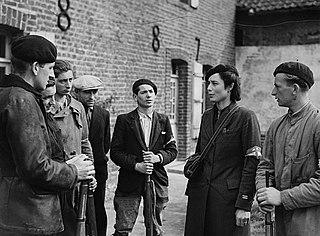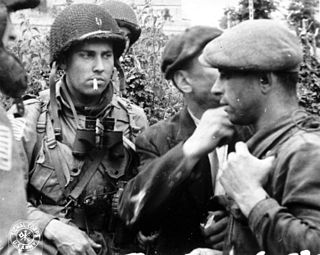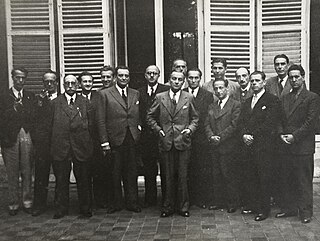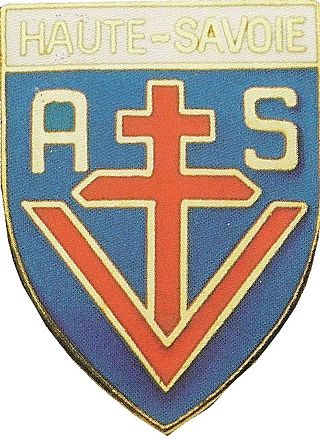
The Maquis were rural guerrilla bands of French and Belgian Resistance fighters, called maquisards, during World War II. Initially, they were composed of young, mostly working-class, men who had escaped into the mountains and woods to avoid conscription into Vichy France's Service du travail obligatoire which provided forced labor for Germany. To avoid capture and deportation to Germany, they became increasingly organized into active resistance groups.

The National Front for an Independent France, better known simply as National Front was a World War II French Resistance movement created to unite all of the resistance organizations together to fight the Nazi occupation forces and Vichy France under Marshall Pétain.

The Francs-tireurs et partisans français, or commonly the Francs-tireurs et partisans (FTP), was an armed resistance organization created by leaders of the French Communist Party during World War II (1939–45). The communist party was neutral at first, following the Soviet Union's official view that the war was a struggle between imperialists, but changed to a policy of armed resistance against the German occupation of France after Germany invaded the Soviet Union in June 1941. Three groups were formed, consisting of party members, young communists and foreign workers. Early in 1942 they were merged to form the FTP, which undertook sabotage and assassinations of the occupation. The FTP became the best organized and most effective of the French Resistance groups. In March 1944, before the Allied forces returned to Normandy, the FTP was theoretically merged with the other Resistance groups. In practice, it retained its independence until the end of the war.
The Francs-tireurs et partisans – main-d'œuvre immigrée (FTP-MOI) were a sub-group of the Francs-tireurs et partisans (FTP) organization, a component of the French Resistance. A wing composed mostly of foreigners, the MOI maintained an armed force to oppose the German occupation of France during World War II. The Main-d'œuvre immigrée was the "Immigrant Movement" of the FTP.

Combat was a large movement in the French Resistance created in the non-occupied zone of France during the World War II (1939–1945).

The National Council of the Resistance directed and coordinated the different movements of the French Resistance during World War II: the press, trade unions and political parties hostile to the Vichy regime, starting from mid-1943.
Paul Chenailler, better known under the pseudonym Colonel Morice, was in charge of the French Resistance in the Morbihan region Brittany during World War II.

The Maquis du Limousin was one of the largest Maquis groups of French resistance fighters fighting for the liberation of France.

The armée secrète was a French military organization active during World War II. The collective grouped the paramilitary formations of the three most important Gaullist resistance movements in the southern zone.

Mouvements unis de la Résistance was a French Resistance organisation, resulting from the consolidation of three major Resistance movements in January 1943 and also the merger of the military arms of these movements within the Armée secrète. Its committee was headed by Jean Moulin. These three then merged with five other major movements to form the Conseil National de la Résistance.
Franc-Tireur was a French Resistance movement of centrist political orientation and the smallest of the three founding member-organisations of the Mouvements Unis de la Résistance in 1943.
The Maquis Vallier was one of the maquis groups of resistance fighters during World War II. The maquis operated in the north of the Var département, particularly in the valley of the Verdon.
Réseau Morhange was a French resistance group created in 1943 by Marcel Taillandier in Toulouse. The group organised direct action and counterintelligence against the German occupiers and collaborators of Vichy France.
The Organisation de résistance de l'armée, O.R.A. was a French paramilitary resistance organisation during the Second World War. It was created on 31 January 1943, following the November 1942 German invasion of the zone libre as a self-styled apolitical organisation bringing together former French military personnel in pursuit of active resistance against the German occupiers, but rejecting Charles de Gaulle.
Émile Fouchard was a French politician.
Known by several names, including 'Comité de Front national des musiciens', the Front national des musiciens was an organisation of musicians in Nazi occupied France that was part of the French Resistance set up at the instigation of the French Communist Party, in May 1941. Active until the autumn of 1944, the group's most prominent members were composers Elsa Barraine and Louis Durey, and conductor Roger Désormière.
Noyautage des administrations publiques, also known by the abbreviation NAP, was an arm of the French Resistance, started by André Plaisantin of the Combat movement, with the aim of infiltrating the Vichy Government. It was started in 1942 on a suggestion from Claude Bourdet to Jean Moulin.
The Volontaires de la Liberté was a French resistance group founded in May 1941. Consisting of school boys and led by Jacques Lusseyran, the group's activities consisted initially of propaganda; it published a bulletin that agitated against the Nazi occupation and the regime of Vichy France. After the Service du travail obligatoire, the Compulsory Work Service, was installed by the Nazis in February 1943 the group's size increased and it dispersed, in part due to ideological differences, many members joining the larger, militant Défense de la France to engage in armed combat. Others continued under the Volontaires name and aided other resistance organizations by sheltering downed Allied pilots.

The clandestine press of the French Resistance was collectively responsible for printing flyers, broadsheets, newspapers, and even books in secret in France during the German occupation of France in the Second World War. The secret press was used to disseminate the ideas of the French Resistance in cooperation with the Free French, and played an important role in the liberation of France and in the history of French journalism, particularly during the 1944 Freedom of the Press Ordinances.

Jean-Pierre Lévy was a French Jewish industrialist and Second World War resistance leader. He worked in the textile industry before being called up as a reserve officer ahead of the war. After the fall of France Lévy joined the resistance and in 1941 co-founded the Franc-Tireur movement. He led the organisation and edited its newspaper. After meeting with Jean Moulin he agreed to help co-ordinate resistance movements in France and went on to join the directorate of the Mouvements unis de la Résistance (MUR). Lévy left France in April 1943 to meet resistance leaders and Charles de Gaulle in London and Algiers. He returned in July and was arrested in October. Lévy was freed by a MUR raid and joined the National Council of the Resistance. He was present at the August 1944 liberation of Paris.









